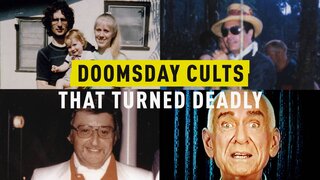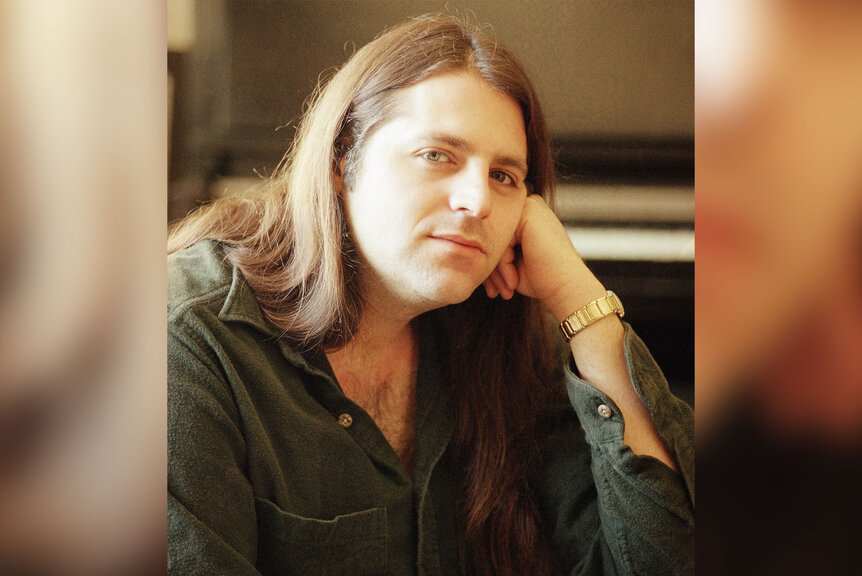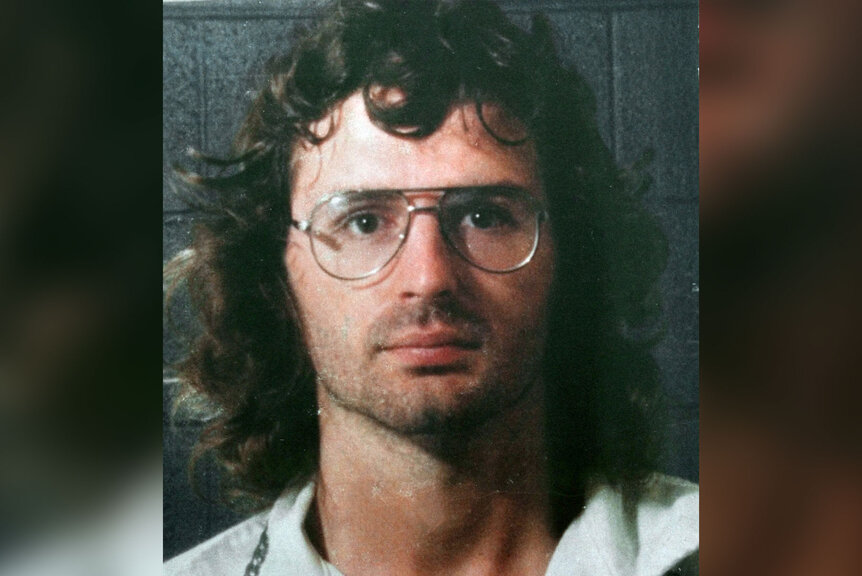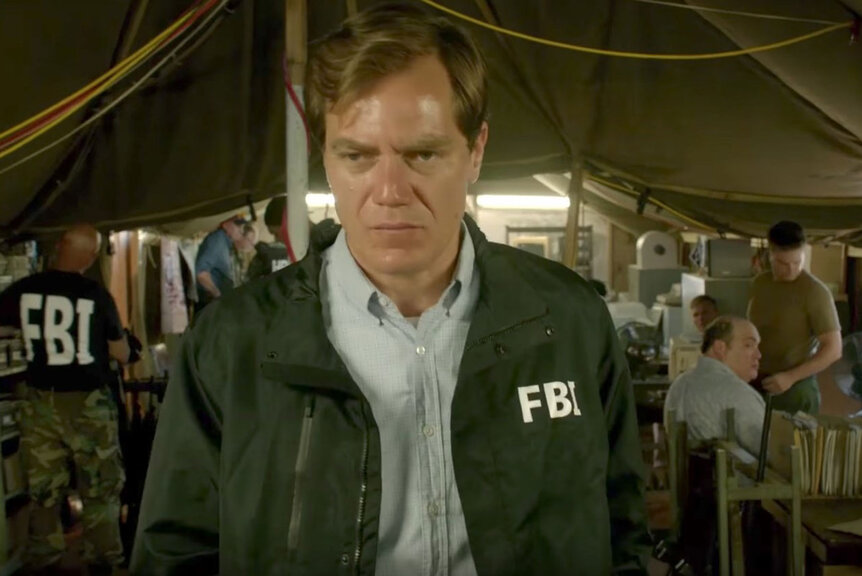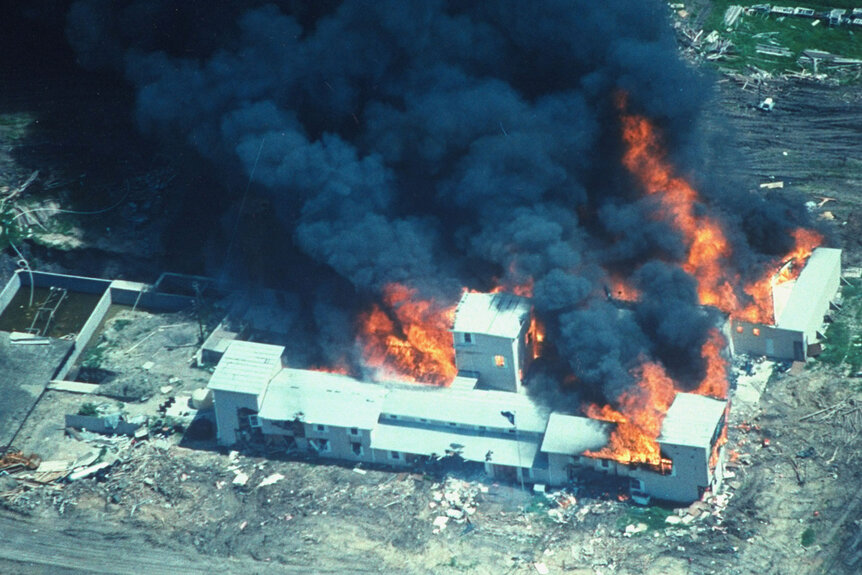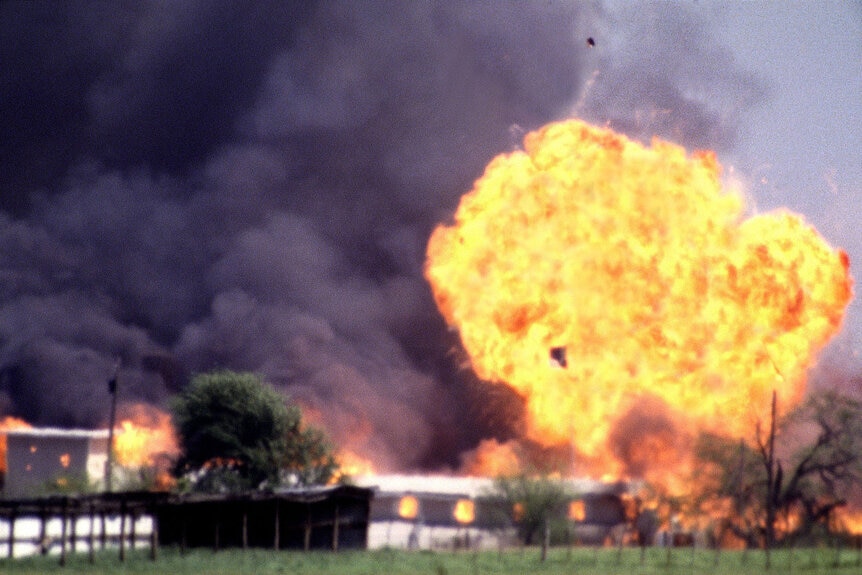Create a free profile to get unlimited access to exclusive videos, breaking news, sweepstakes, and more!
Is David Thibodeau In 'Waco' Based On A Real Person And Did That Siege Rock Concert Really Happen?
David Thibodeau and Branch Davidian leader David Koresh gave an impromptu concert for FBI agents after they cut the power to the compound in "Waco."
The television series “Waco” devotes a good portion of its screen time to character David Thibodeau, a drummer who met Branch Davidian leader David Koresh (Taylor Kitsch) at a Los Angeles bar. Koresh asks him to fill in as drummer in his band, ultimately leading Thibodeau (Rory Culkin) to move into the Mount Carmel compound which later became the backdrop for a deadly siege.
Netflix recently added “Waco” — a dramatized account which brings the tragic events of the deadly 1993 Waco, Texas siege to life — to its streaming library where it quickly became a top 10 hit. The show first premiered on the Paramount Network in 2018.
In the series, Thibodeau visits the compound shortly after meeting Koresh where he becomes fascinated the Branch Davidian way of life. Soon, he moves onto the compound where Koresh asked him to marry teen Michelle Jones (Julia Garner) who had a child with Koresh years earlier.
As the show depicts, Child Protective Services were investigating allegations of child abuse inside the compound by 1992. Koresh was also getting a lot of heat for having several teenage wives, including Jones who he married well before legal age. At the same time, the ATF was also investigating possible federal gun violations inside the compound. This led to an ATF raid in Feb. 1993 which soon turned deadly, resulting in deaths of both Branch Davidians and ATF agents. That triggered the now-infamous FBI led 51-day standoff.
The former head negotiator in the stand-off has since conceded that the FBI made many mistakes during the siege, including overtly-aggressive tactics toward the Branch Davidians.
In one of the show's most cinematic moments, Thibodeau and Koresh perform an impromptu concert for the tanks surrounding the compound. It was one of the few somewhat joyous moments in the dramatized version of the tragic siege. By April 19, the FBI sent tear gas into the compound with tanks and soon after the building went up in flames. It led to 76 Branch Davidians, including 25 children, losing their lives.
What actually happened that day has long been a point of contention in the public's eye. While the group was often portrayed as a dangerous doomsday cult with suicidal ideation, others have maintained they were unfairly targeted by the government. While the FBI has maintained that the Branch Davidians started the fire and committed a mass suicide, others vehemently reject that assessment.
Throughout the entire ordeal, 82 Branch Davidans died and 4 ATF officers were killed. In the series, Thibodeau leaps from the building just in the nick of time and survives.
Is Thibodeau based on a real person?
Yes, the character David Thibodeau is based off a real person and drummer of the same name.
Only 9 Branch Davidians survived the siege’s fiery conclusion and Thibodeau was one of them. He went on to write “Waco: A Survivor’s Story” in 1999, which serves as half of the basis for “Waco.” It is also based off of former FBI hostage negotiator Gary Noesner’s 2010 book “Stalling for Time: My Life as an FBI Hostage Negotiator.”
Thibodeau told Oxygen.com he wrote the book "out of frustration with the way everyone was characterized and demonized in the country. It just wasn’t right. I literally wrote the book because I was so mad about it all. I had no desire to be an author. I just wanted to play drums."
He and Koresh initially met at a Guitar Center in Los Angeles and they jammed soon after, he detailed in his book. He was then invited to Mount Carmel where he became fascinated by Koresh’s understanding of both the Old and New Testaments. Soon, he moved onto the compound and began studying the scriptures. He also — as he did in the show — married a woman named Michele Jones in a “sham marriage” to deflect investigators. Like in the show, Jones had married Koresh and had his child when she was 12.
The Branch Davidian depiction
While Noesner previously told Oxygen.com that he thinks the show “painted too positive or sympathetic of a picture of Koresh” — whom Noesner also called “sinister” and “manipulative — Thibodeau said he felt like the depiction of Koresh was fair.
“That was actually the kind of person that he was,” he said, adding that Koresh’s knowledge of the Bible is what attracted people to him and not his personality.
“The guy was not charismatic,” Thibodeau said. “He was not somebody you just wanted to be with or hang out with. You wanted to hang out with him because of his wisdom, a depth of knowledge of the scripture.”
Thibodeau, who is from Maine, added that he didn’t feel like he and Koresh were alike personally.
“He was southern and redneck-y and I am very northern.”
Koresh's followers were from all walks of life and many were educated and successful, Thibodeau points out. Wayne Martin, for example, was a Harvard-educated lawyer, the Waco Tribune-Herald reported in 1993.
“It’s easy to think the people were very stupid and just needed a leader,” Thibodeau said. “The people surrounding him were some of the brightest I’ve ever known.”
He also pointed out that people from all over the world and of different races lived there. He said the group denounced racism. Waco is often compared to Ruby Ridge where an FBI standoff went rogue, resulting in the deaths of the white supremacist target’s wife and son.
Thibodeau said back in the 1990s he and his peers were viewed as “crazy cult” followers, and nothing more. A 2019 Penn Today story explains that the term “cult” can be subjective, pointing out that many groups that were once considered cults are now deemed actual religions.
“When you think cult, you always want to put the word Satanic in front of it. You just think evil and wrong and manipulation and control,” Thibodeau told Oxygen.com. “Every group was a cult at one time: the Protestants, the Catholics, the Mormons; they were considered strange groups of their time.”
Dr. Megan Goodwin, a visiting professor at Northeastern University who studies American minority religions told Oxygen.com that "we [the United States government] very much use minority religions' different views on sex as a reason for them to be policed, surveilled and controlled. We use that as a reason to have tanks sent against them as was done at Waco."
She argues that sex abuse, albeit horrible, is common and happens everywhere.
"No one is sending tanks into your local Catholic church parking lot," she told Oxygen.com. "We mark these minority religions as legitimate targets of violence in ways that we do not discipline and punish major traditional religions. We should absolutely care about sex abuse everywhere, we should absolutely care about folks who use religion as a way to abuse children but I don't think the answer to child sex abuse is ever going to be tanks."
Goodwin did say that the show appears to gloss over some of the more serious sex abuse allegations made against the group.
"It seemed like an interesting choice which I assume was to try to make the community more sympathetic," she said.
Noesner told Oxygen.com that he also felt the series glossed over certain aspects of the Branch Davidians.
"I think watching the show just left someone with the feeling that these people were more victims than in some ways they really were," he said.
Thibodeau told Oxygen.com that he feels like the show depicted the Branch Davidians accurately.
“They were good people who were there following their belief in God,” he said. “They were very, very good people who were unfairly demonized, as far as I’m concerned, in the press.”
The depiction of the siege
That seemingly outlandish impromptu concert depicted in the show really did happen, according to Thibodeau.
“David said ‘those guys out there in the tanks and everything, they’re just doing their jobs. Play some music for them.” So we put the speakers in the windows,” Thibodeau recalled to Oxygen.com.
Just as in the show, they played on a generator during an FBI-led power outage. Thibodeau said they played original music for FBI agents for about half an hour.
He told Oxygen.com the concert occurred shortly before the FBI began blasting annoying and bizarre sounds into the compound, which sometimes included music. They played Buddhist chanting, phones beeping off the hook, the sounds of rabbits being slaughtered, and Nancy Sinatra’s “These Boots Are Made For Walkin'.”
“You know, Nancy Sinatra’s “These Boots Are Made For Walkin',” once you listen to it once or twice you’re good. When you have to listen to it for an entire day, it’s like maybe you guys should just kill us,” Thibodeau joked.
Noesner previously told Oxygen.com that these agitation and deprivation techniques were done over his head and that they are not FBI protocol.
“It just made us look so stupid and foolish,” Noesner said.
In the series, Noesner was incessantly frustrated with the other commanders he was working with. While he tried to get the Branch Davidians to surrender peacefully so they could face the sex abuse and gun allegations, his peers seemed deadset on using more aggressive, violent methods. The lead FBI commanders on the job, minus Noesner, were depicted as clueless, aggressive and disorganized. They butted heads with Noesner before booting him off the siege so that they could go ahead with brute force.
Noesner told Oxygen.com that the show did accurately depict in-fighting and some of the mistakes made at Waco. Still, Thibodeau told Oxygen.com that he doesn’t think the show “went far enough” in its depiction of federal agents. He argued that the FBI agents actually looked "smarter" in the show than he thinks they were.
“They lied,” he alleged of the FBI. “They lied so often to the American public about everything.”
He said he felt as if events were covered up and softened following the siege and pointed out that then-Attorney General Janet Reno compared using an unarmed tank at Waco to “a good rent-a-car” in a 1995 hearing about Waco. Goodwin told Oxygen.com that even if the tanks were unarmed, "if they show up in my front lawn it looks like tanks and it looks like the federal government has sent tanks against United States citizens."
In 1999, Reno appointed special counsel John Danforth to lead an investigation into the FBI's role in the siege which resulted in the "Danforth Report," also known as the "Waco Report," published in 2000. Thibodeau vehemently said he does not believe the FBI’s claim, included in that report, that the fire was started by Branch Davidians inside the compound.
FBI agents claim it was Davidians themselves who admitted to watching their peers start the blaze.
"Graeme Craddock, a Davidian who survived the fire, told the Office of Special Counsel in 1999 that he observed other Davidians pouring fuel in the chapel area of the complex on April 19, 1993," the report states. "He further stated that he saw another Davidian, Mark Wendel, arrive from the second floor yelling: 'Light the fire.'"
Thibodeau said that wasn't what he observed.
“I did not see anyone start a fire,” he told Oxygen.com. “Nobody in my area was talking about lighting fires. Somebody yelled ‘there's a fire’ upstairs. I remember hearing that.”
Clive Doyle, another Waco survivor and Branch Davidian told the Star-Telegram a similar recollection in 2013.
"I never saw anybody light the fires," Doyle said. "I was in the chapel area, by the front door. The FBI was gassing us all morning. I heard someone yelling from upstairs that the building was on fire."
Noesner told Oxygen.com that hidden microphones inside the compound caught Davidians saying “light the fire.” Those tapes were played for a federal grand jury in Aug. 1993, the Houston Chronicle reported in 1993. Thibodeau testified about the tapes to the grand shortly before 12 Branch Davidians were charged with conspiracy and other crimes related to the deaths of the 4 ATF agents. That indictment claimed that just one day before the siege's conclusion, Koresh and his top aide decided they would burn down the compound if the FBI tried to conclude the siege.
Thibodeau, who was not indicted on any charge, reflected that he and other survivors in the room couldn't make out what the tapes were saying.
“None of us could understand what these tapes were saying,” he said. “They gave us a paper which said what they believe it said.”
At the point in which the transcript claims someone says “light the fire,” Thibodeau said “to me it said ‘cut the power.’"
He added, "Yet this is what they wanted to hear so they wrote it down to make it a reality for people."
Thibodeau also claims that phrase was picked up by microphones six hours before the actual fire began. The FBI has not immediately responded to Oxygen.com’s request for access to those audio files.
The drummer said he believes that the fires may have started on their after tanks crashed into the building to release the tear gas. He said every room had a lantern because of the outage. Tear gas is also known to be incendiary.
“It was very conducive of a fire starting in that building,” Thibodeau told Oxygen.com.
At the time, conspiracy theories circulated that the government intentionally set the building on fire. A 1999 Time magazine poll showed that 61 percent of Americans thought that was case, the Forth Worth Star-Telegram reported in 2013.
In the "Danforth Report," Danforth concluded that "based on a 14-month investigation, I am 100 percent certain that on April 19, 1993, the government did not set fire to the Branch Davidian complex, did not direct gunfire at the Branch Davidians and did not illegally use the military in a civilian law enforcement operation."
The report states that as the fire began to spread in the compound, "FBI agents heard gunfire within the complex. They stated that some of the rounds sounded 'cooked off' by the heat, but that others were rhythmic in nature, leading some of the agents to conclude at the time that the Davidians were committing mass suicide."
Thibdoeau said he doesn’t believe this FBI claim that many of the Branch Davidians perished in a mass suicide.
“Some people did take their own lives but they were stuck in rooms where they were being gassed to death and some of the kids literally suffocated from the gas,” he said. “Some people didn’t feel like burning to death so they shot themselves. Some mothers had to kill their babies first so their babies wouldn’t suffer. It was horrendous the decisions some of these people had to make during the last seconds of their lives.”
Thibodeau, who ran out of the building while it was ablaze, told Oxygen.com he and his peers were scared to leave because they thought the federal agents would shoot them.
“We didn’t believe them, they lied to us,” he said. “The only reason I left is because I heard my hair crackle and I would rather be shot than burn to death.”
What was life like after?
Thibodeau told Oxygen.com he felt alone in the immediate aftermath. He claimed that nobody — including the ACLU, Amnesty International or any other civil liberties group — was there to help the survivors. He said he grew frustrated that mainstream media outlets didn’t want to hear their side.
“I thought, being raised by a Democratic family listening to National Public Radio and other great intellectual sources that these people would want to really know what happened at Mount Carmel,” he told Oxygen.com. “Nobody wanted to talk to me. I was that cult guy.”
He said that only right-wing and militia groups would listen to him at the time.
“I couldn't find the audience I wanted,” he said. “I had to take the audience that would listen. It was the only the patriotic type of people who would listen to me. That was very sad that America was that close minded but we really were when it came to Waco.”
Thibodeau wrote in his book that he struggled with anger issues and post traumatic stress disorder as a result of being at Mount Carmel during the deadly siege.
“I went through a long phase of drugs and alcohol,” he told Oxygen.com. “I didn't want to feel the pain anymore. I was confused and mad.”
Thibodeau has since stopped drinking and said he “took his soul” back.
He still plays music and is in the Maine rock band The Blast Addicts. Thibodeau lives in Maine but recently visited Waco to gather information for a new Waco survivors website he made and for a new non-profit he is working on called the Mount Carmel Historical and Preservation Fund.
“We want to raise money to try to get the land from the current owner who has basically kicked all the survivors off,” he said of the fund.
Following the success of the series, he noticed that the public perception of the Waco events has shifted.
“I’m getting soccer moms that are just mad as hell and they want to get on a bus and go to Washington,” he said.
Thibodeau said that hundreds of people have reached out to him to offer their support of what he went through.
“That just means so much to me,” he said.
"Waco" is available to stream on Netflix.
